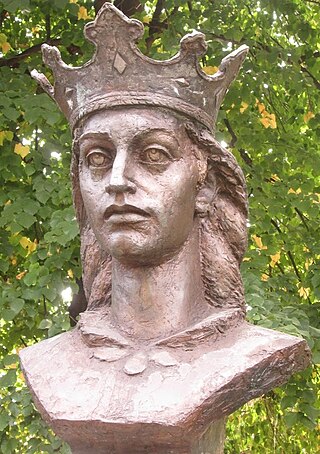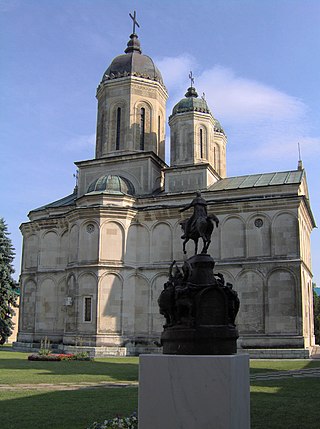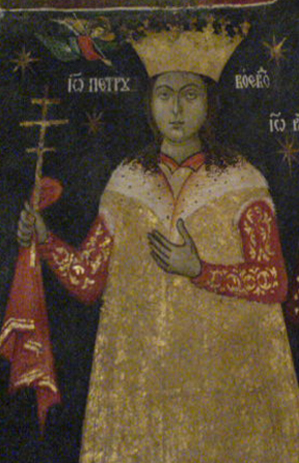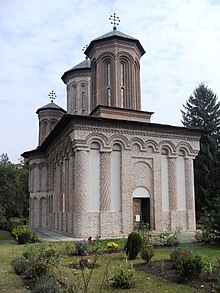
Wallachia or Walachia is a historical and geographical region of Romania. It is situated north of the Lower Danube and south of the Southern Carpathians. Wallachia is traditionally divided into two sections, Muntenia and Oltenia. Dobruja could sometimes be considered a third section due to its proximity and brief rule over it. Wallachia as a whole is sometimes referred to as Muntenia through identification with the larger of the two traditional sections.

Mircea the Elder was the Voivode of Wallachia from 1386 until his death in 1418. He was the son of Radu I of Wallachia and brother of Dan I of Wallachia, after whose death he inherited the throne.

John Hunyadi was a leading Hungarian military and political figure in Central and Southeastern Europe during the 15th century. According to most contemporary sources, he was the member of a noble family of Wallachian ancestry. He mastered his military skills on the southern borderlands of the Kingdom of Hungary that were exposed to Ottoman attacks. Appointed voivode of Transylvania and head of a number of southern counties, he assumed responsibility for the defense of the frontiers in 1441.

Radu III of Wallachia, commonly called Radu the Handsome, was the younger brother of Vlad III and prince of the principality of Wallachia. They were both sons of Vlad II Dracul and his wife, Princess Cneajna of Moldavia. In addition to Vlad III, Radu also had two older siblings, Mircea II and Vlad Călugărul, both of whom would also briefly rule Wallachia.

Vlad II, also known as Vlad Dracul or Vlad the Dragon, was Voivode of Wallachia from 1436 to 1442, and again from 1443 to 1447. He is internationally known as the father of Vlad the Impaler, or Dracula. Born an illegitimate son of Mircea I of Wallachia, he spent his youth at the court of Sigismund of Luxembourg, who made him a member of the Order of the Dragon in 1431. Sigismund also recognized him as the lawful Voivode of Wallachia, allowing him to settle in nearby Transylvania. Vlad could not assert his claim during the life of his half-brother, Alexander I Aldea, who acknowledged the suzerainty of the Ottoman Sultan, Murad II.

Vlad III, commonly known as Vlad the Impaler or Vlad Dracula, was Voivode of Wallachia three times between 1448 and his death in 1476/77. He is often considered one of the most important rulers in Wallachian history and a national hero of Romania.
Vlad is a Romanian male given name. It is more commonly a nativized hypocorism of Vladislav and can also be used as a surname. Alternately, it may be a hypocoristic form of the Slavic name Vladimir. It may refer to:

Dan II cel Viteaz was a voivode of the principality of Wallachia, ruling an extraordinary five times, and succeeded four times by Radu II Chelul, his rival for the throne. Of those five periods on the throne of Wallachia, four were within a period of only seven years.
Mircea II (1428–1447) was the Voivode, or prince, of Wallachia in 1442. He was the oldest son of Vlad II Dracul and brother of Vlad Țepeș and Radu the Handsome. He was the grandson of his namesake Mircea cel Bătrân.
Basarab II was the Voivode of the principality of Wallachia (1442–1443), and the son of the former Wallachian ruler Dan II of Wallachia. Basarab II ruled during a turbulent time in Wallachia, now part of present-day Romania, with his rule falling between that of the father and son rule of Vlad Dracul and Mircea II. His reign was extremely short, as during that period only the strongest could retain their hold on the region for any great length of time. He took over as ruler in August 1442, holding on to it only until the Autumn of 1443, when Vlad Dracul forced him out.

Vlad IV Călugărul was the Prince of Wallachia in 1481 and then from 1482 to 1495.

Corvin Castle, also known as Hunyadi Castle or Hunedoara Castle, is a Gothic-Renaissance castle in Hunedoara, Romania. It is one of the largest castles in Europe and is featured as one of the Seven Wonders of Romania.

Vlad VI of Wallachia was the voivode (prince) who ruled Wallachia between June 1530 and September 1532. He has been historically referenced as Vlad Înecatul, as a description of the manner of his death.

Dealu Monastery is a 15th-century monastery in Dâmbovița County, Romania, located 6 km north of Târgoviște.
The House of Drăculești were one of two major rival lines of Wallachian voivodes of the House of Basarab, the other being the House of Dănești. These lines were in constant contest for the throne from the late fourteenth to the early sixteenth centuries. Descendants of the line of Drăculești would eventually come to dominate the principality, until its common rule with Transylvania and Moldavia by Mihai Viteazul in 1600.
Radu of Afumați was Voivode (Prince) of Wallachia between January 1522 and January 1529. He began his reign with a victory against Mehmed-bey, a pretender to Wallachia's throne. From 1522 to 1525 he battled the Turks, who supported Vladislav III and Radu Bădica, both claimants of the throne. The inscription on his tombstone lists 20 battles. He was killed by decapitation on 2 January 1529 near Râmnicu Vâlcea, at Cetățuia Church. He was later buried in the Curtea de Argeș Cathedral.

Peter the Younger was the Voivode (Prince) of Wallachia between 25 September 1559 and 8 June 1568. The eldest son of Mircea the Shepherd and Doamna Chiajna, he was named "the Young" because, at the moment of crowning, he was only 13.
Vlad V cel Tânăr was the Prince of Wallachia (1510–1512). He took the throne from Mircea III Dracul on 8 April 1510 with the help of the Ottomans and with the support of the Craiovești family. In exchange, the prince vowed protection to Mehmet and his family and Parvu Craiovescu, a member of the Craiovești family, became the head of the Divan of Wallachia. Parvu was then followed by Danciu and in 1511, by Bogdan, the Prince's brother-in-law.

Dan the Younger was a pretender to the throne of Wallachia from 1456 to 1460. He was the son of Dan II of Wallachia who died fighting for the throne in 1431. After Dan's brother, Vladislav II of Wallachia, was killed by their cousin, Vlad Dracula, in a duel in 1456, Dan settled in Brașov. Besides Dan, Vlad Dracula's half-brother, Vlad the Monk, and Dan's brother, Basarab Laiotă, laid claim to Wallachia against Dracula. Dan tried to seize Wallachia with the support of the burghers of the town, but he was defeated and captured in a battle near Rucăr. He was forced to dig his own grave before being beheaded.
The boyars of Fogaras were a group of Vlach conditional nobles in the medieval Kingdom of Hungary and the Principality of Transylvania.














